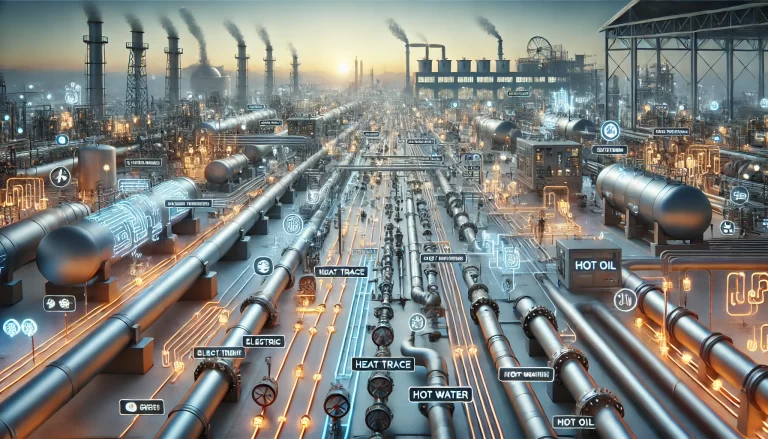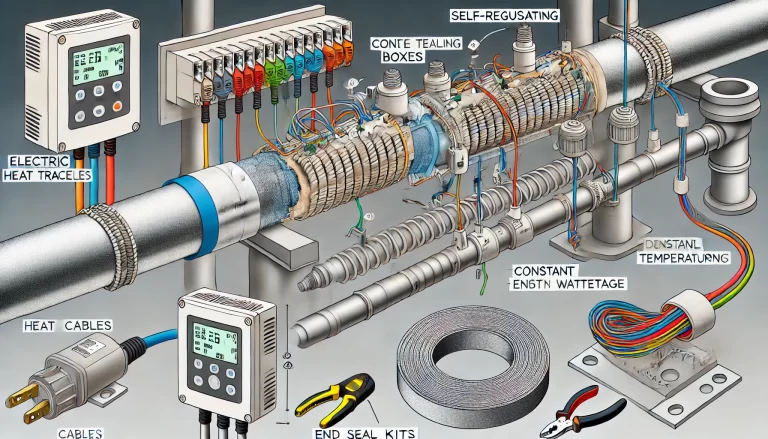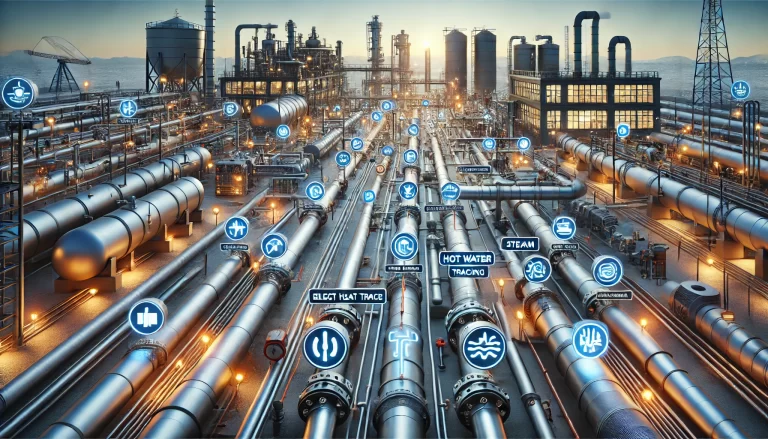1. Incident Overview
In chemical production or other industrial scenarios involving instrument heat tracing and steam systems, errors during the welding of heat tracing pipes can lead to severe issues. For example, heat tracing pipes may be mistakenly connected to oil system pipelines in the steam system or accidentally linked to isolated oil systems during welding. As a result, when the steam system is in operation, oil from the incorrect pipeline may enter the steam system, leading to oil contamination.

2. Potential Consequences
2.1 Production Impact
Oil contamination can pollute the steam, impairing the normal functioning of equipment that relies on steam for power or heat, such as steam-driven pumps and turbines. This can lead to operational failures, decreased production efficiency, and, in severe cases, production stoppages.
2.2 Equipment Damage
The introduction of oil into steam pipelines can result in the accumulation of oil residue on the internal surfaces of pipes and related equipment. This can decrease the heat transfer efficiency of the steam, cause pipe blockages, and accelerate equipment wear, potentially reducing the operational lifespan of crucial machinery.
2.3 Safety Risks
For steam systems operating in high-temperature, high-pressure, or potentially hazardous environments, oil contamination can pose significant safety risks. The presence of oil may lead to the risk of fire or explosion, endangering personnel and compromising facility safety.
2.4 Environmental Impact
Oil-contaminated steam released into the environment can cause severe pollution to soil, water bodies, and ecosystems, violating environmental regulations. The leakage of oils and oil-containing wastewater into the environment can lead to long-term ecological damage.

3. Preventive Measures
3.1 Design Review
During the project design phase, it is essential to conduct thorough reviews of the design blueprints for the instrument heat tracing system and steam system. Special attention should be given to pipeline connections and routing to avoid potential design flaws that could lead to oil contamination.
3.2 Construction Management
Personnel Qualifications: Ensure that welders and construction workers possess the necessary certifications and experience. They should undergo specialized training and be familiar with relevant welding techniques and quality standards.
Technical Briefing: Before construction begins, technical personnel should conduct a detailed briefing for the construction team, outlining welding requirements, process parameters, and correct pipeline connections to ensure everyone is clear about the work and quality standards.
Process Supervision: Assign personnel to supervise the welding process. Close oversight ensures compliance with safety protocols and allows for real-time corrections to any operational mistakes or safety violations.
Stringent Inspections: After welding, conduct thorough inspections in accordance with relevant standards. This includes visual checks, non-destructive testing (NDT), and pressure testing to ensure the welds are free of defects and leaks.
3.3 System Testing and Commissioning
Once installation is complete, conduct extensive commissioning tests for both the steam system and the instrument heat tracing system. Perform pressure tests, flow tests, and system checks to detect any potential faults, including the risk of oil contamination.
3.4 Training and Awareness
Regular training should be provided to both operational and maintenance staff, ensuring they are familiar with system operation, workflows, potential issues, and proper troubleshooting techniques. This can significantly reduce the chances of operational errors.

4. Emergency Measures in the Event of Oil Contamination
If oil contamination occurs in the steam system due to an error in welding the heat tracing pipes, it is crucial to implement quick and effective emergency response measures to minimize damage. The following steps should be taken:
4.1 Immediate Shutdown of Affected Systems
Cut Off Steam Supply: Immediately close the main steam valve to halt steam delivery, preventing the spread of oil throughout the system and further contamination of equipment and pipelines.
Shut Down Affected Equipment: Turn off any equipment linked to the steam system that could be impacted by oil contamination, such as steam-driven pumps, compressors, and heat exchangers. This prevents further equipment damage and reduces the risk of secondary accidents.
4.2 Prevent Leakage and Spread of Oil
Identify Leakage Points: Engage qualified professionals to quickly assess and identify the exact location of the oil contamination within the steam system. Focus on weld points, valve connections, and other potential sources of leaks.
Seal Leaks: Apply appropriate sealing methods to contain the oil spill. For minor leaks, sealant materials like sealant gel can be used. For larger leaks, temporary mechanical sealing such as clamps or pipe collars may be needed to prevent further spillage.
Install Barriers and Collection Systems: Erect barriers around the contaminated areas to prevent oil from spreading to other parts of the facility. Additionally, set up collection devices such as containment trays, tanks, or barrels to gather leaked oil and contaminated water.
4.3 Oil Removal and Cleaning
Oil Discharge and Collection: Safely open the system’s drainage valves and those of affected equipment to remove oil and oil-contaminated water into designated containment containers. Ensure the entire system is drained thoroughly and effectively.
Washing and Cleaning: Use clean water or suitable cleaning agents to flush out remaining oil residues from the pipelines and equipment. The cleaning process should be controlled in terms of pressure and flow to avoid system damage.
Drying and Purging: After cleaning, dry the system using compressed air or nitrogen to eliminate any residual moisture. This step is critical to prevent rusting and to ensure the system is fully cleared of contaminants.
4.4 Safety and Monitoring
Personal Protection: All personnel involved in the emergency response must wear appropriate personal protective equipment (PPE), including gas masks, gloves, and protective suits, to prevent exposure to harmful substances and steam.
Environmental Monitoring: Assign environmental monitoring personnel to assess the impact of the contamination. Key factors such as air quality, soil pollution, and water contamination should be regularly monitored, and corrective actions should be taken to minimize environmental harm.
Equipment Testing: After the cleaning process, conduct full equipment diagnostics, including performance tests and non-destructive evaluations, to assess the extent of damage caused by oil contamination. Develop repair or replacement plans based on the severity of the damage.
4.5 Restoration of Normal Operation
System Inspection and Commissioning: Once cleaning and repairs are completed, perform thorough inspections to ensure no residual contaminants remain in the system. Gradually restart the steam supply, ensuring that all components are functioning normally.
Acceptance and Evaluation: Following the restoration of the steam system, carry out a formal acceptance check. Evaluate the entire incident to identify the root cause, evaluate the effectiveness of the emergency response, and implement corrective actions to prevent recurrence.
